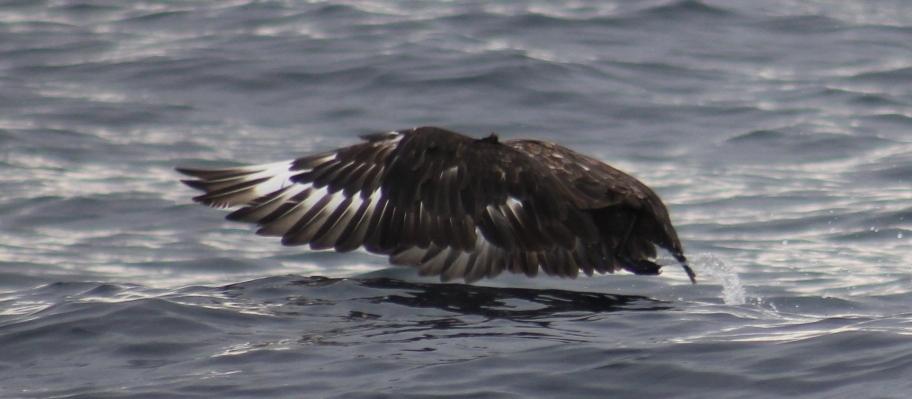July 5 - 11, 2015: Issue 221
Sea Birds off the Pittwater Coast: Albatross, Gannet, Skau
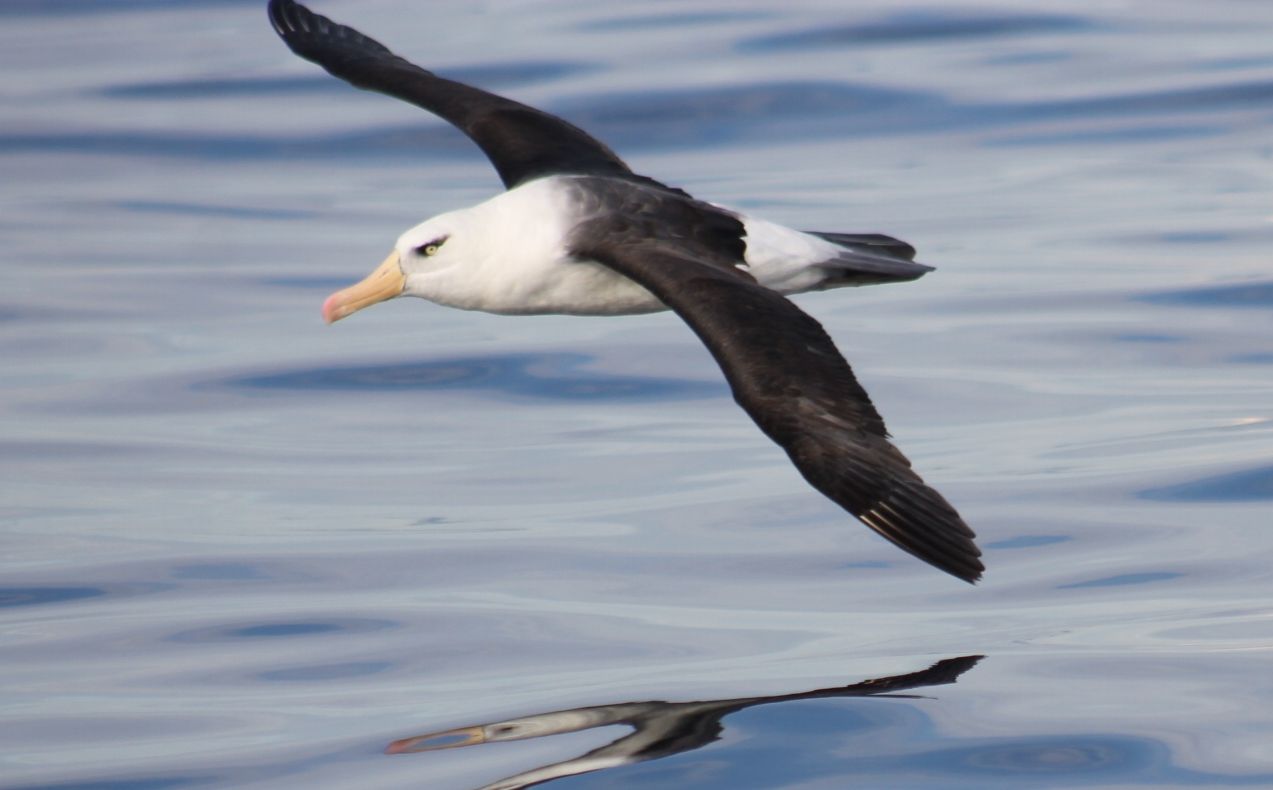
Black-browed Albatross (Thalassarche melanophrys) - picture by A J Guesdon, 2015
Sea-birds off Pittwater; The Black-browed Albatross, Australasian Gannet and Brown Skua
Far from our cliffs, and even flying on updrafts to them, are seabirds that live in our marine environment. The first seabirds evolved in the Cretaceous period(from circa 145 ± 4 to 66 million years ago), and modern seabird families emerged in the Paleogene (between 66 and ended 23.03 million years ago).
Seabirds generally live longer, breed later and have fewer young than other birds do, but are known for spending a great deal of time ensuring their young grow big and strong. Most species nest in colonies, which can vary in size from a few dozen birds to millions. Many species are famous for undertaking long annual migrations, crossing the equator or circumnavigating the Earth in some cases. They feed both at the ocean's surface and below it, and some kinds even feed on each other. Seabirds can be highly pelagic, coastal, and in some cases spend a part of the year away from the sea entirely.
Many species are currently threatened by human activities, most recently the effects of plastic pollution in our oceanic waters have become apparent as yet another very good reason to ensure you do not discard anything plastic and begin to re-gear your life so you can live plastic-free.
This week the wonderful people form Living Ocean afforded us an opportunity to bring you some information about three of these we photographed off Pittwater – the Black-browed Albatross (Thalassarche melanophrys), Australasian gannet (Morus serrator or Sula bassana), and the Brown Skua, (Stercorarius antarcticus), also known as the Antarctic skua.
These birds have a long history of providing inspiration and informing us of how we too can learn from what is in and on the ocean; they have guided fishermen to fish and sailors to land as well as contributing knowledge of other kinds to us. Possibly one of the more famous poems our younger readers may not yet be acquainted with is that of The Rime of the Ancient Mariner by Poet Samuel Taylor Coleridge 1772–1834, in which the ‘Mariner’ relates his selfish carelessness causing the death of an albatross, long taken by sailors, or ‘mariners’ to be a symbol of good luck, causes bad luck ever after for this man – there are many interpretations and essays on all this great poem means, which you can investigate when ready – we did find some observers of how not looking after Nature and her creatures will ultimately turn beauty and abundance to their opposites quite close to home for you though:
Why Fishing Club Has Been Wound Up.
The "curse” of an offended albatross is held responsible for the end of a deep-sea fishing club at Gosford, New South Wales. It began when the 24 men were fishing out at sea. One of them accidentally hooked a large albatross, the bird which is reputed to bring disaster if harmed as it did to the Ancient Mariner in Coleridge's poem. The bird fought savagely for half an hour before it could be brought aboard to have the hook extracted. Then it battled its way loose, and for three hours refused to leave the launch. Instead it viciously attacked first one and then another of the 24 men. At length it flew away, and the anglers sighed in relief. Their troubles, however, were only beginning.
An hour later, one of the men suffered agonies when a large fish hook became embedded deep in the palm of his hand. As the launch raced for the shore, the hook had to be prised out in an effort to reduce the man's suffering. Soon afterwards the launch grounded on a mudbank, and the men were marooned for three hours until the tide rose. Bad luck continued to dog every outing arranged by the club. Terrific storms prevented several trips. Club membership waned, and all efforts to revive interest failed. At the annual meeting the three remaining members of the original 120 have decided to wind up the club in an effort to avert the albatross “curse”. ALBATROSS “CURSE”. (1936, June 6). Shepparton Advertiser(Vic. : 1914 - 1953), p. 4. Retrieved from http://nla.gov.au/nla.news-article176993041
Doesn't sound too good, does it?
Some information and a few Australian Poet's poems about these wonderful seabirds, which we hope will inspire our youn and a bit older readers to gaze a bit closer at the wonderful seabirds that call to them from the coastlines of Pittwater:
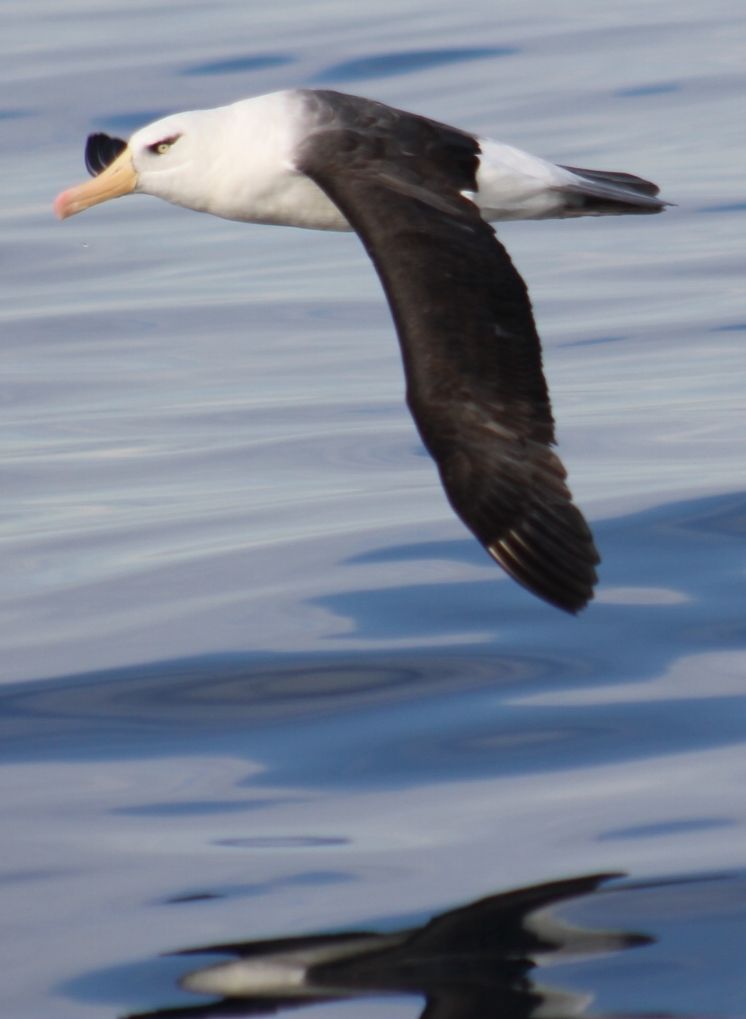 The wise and lucky Black-browed Albatross (Thalassarche melanophrys) - Albatrosses, of the biological family Diomedeidae, are large seabirds allied to the procellariids, storm petrelsand diving petrels in the order Procellariiformes (the tubenoses). They range widely in the Southern Ocean and the North Pacific. They are absent from the North Atlantic, although fossil remains show they once occurred there and occasional vagrants are found. Albatrosses are among the largest of flying birds, and the great albatrosses (genus Diomedea) have the largest wingspans of any extant birds, reaching up to 12 feet (3.7 m). The albatrosses are usually regarded as falling into four genera, but there is disagreement over the number of species.
The wise and lucky Black-browed Albatross (Thalassarche melanophrys) - Albatrosses, of the biological family Diomedeidae, are large seabirds allied to the procellariids, storm petrelsand diving petrels in the order Procellariiformes (the tubenoses). They range widely in the Southern Ocean and the North Pacific. They are absent from the North Atlantic, although fossil remains show they once occurred there and occasional vagrants are found. Albatrosses are among the largest of flying birds, and the great albatrosses (genus Diomedea) have the largest wingspans of any extant birds, reaching up to 12 feet (3.7 m). The albatrosses are usually regarded as falling into four genera, but there is disagreement over the number of species.
 The wise and lucky Black-browed Albatross (Thalassarche melanophrys) - Albatrosses, of the biological family Diomedeidae, are large seabirds allied to the procellariids, storm petrelsand diving petrels in the order Procellariiformes (the tubenoses). They range widely in the Southern Ocean and the North Pacific. They are absent from the North Atlantic, although fossil remains show they once occurred there and occasional vagrants are found. Albatrosses are among the largest of flying birds, and the great albatrosses (genus Diomedea) have the largest wingspans of any extant birds, reaching up to 12 feet (3.7 m). The albatrosses are usually regarded as falling into four genera, but there is disagreement over the number of species.
The wise and lucky Black-browed Albatross (Thalassarche melanophrys) - Albatrosses, of the biological family Diomedeidae, are large seabirds allied to the procellariids, storm petrelsand diving petrels in the order Procellariiformes (the tubenoses). They range widely in the Southern Ocean and the North Pacific. They are absent from the North Atlantic, although fossil remains show they once occurred there and occasional vagrants are found. Albatrosses are among the largest of flying birds, and the great albatrosses (genus Diomedea) have the largest wingspans of any extant birds, reaching up to 12 feet (3.7 m). The albatrosses are usually regarded as falling into four genera, but there is disagreement over the number of species.Albatrosses are highly efficient in the air, using dynamic soaring and slope soaring to cover great distances with little exertion. They feed on squid, fish and krill by either scavenging, surface seizing or diving. Albatrosses are colonial, nesting for the most part on remote oceanic islands, often with several species nesting together. Pair bonds between males and females form over several years, with the use of "ritualised dances", and will last for the life of the pair. A breeding season can take over a year from laying to fledging, with a single egg laid in each breeding attempt. A Laysan albatross, named Wisdom, on Midway Island is recognised as the oldest wild bird in the world; she was first banded in 1956 by Chandler Robbins.
Of the 22 species of albatrosses recognised by the IUCN, all are listed as at some level of concern; 3 species are Critically Endangered, 5 species are Endangered, 7 species are Near Threatened, and 7 species are Vulnerable. Numbers of albatrosses have declined in the past due to harvesting for feathers, but today the albatrosses are threatened by introduced species, such as rats and feral cats that attack eggs, chicks and nesting adults; by pollution; by a serious decline in fish stocks in many regions largely due to overfishing; and bylongline fishing. Longline fisheries pose the greatest threat, as feeding birds are attracted to the bait, become hooked on the lines, and drown. Stakeholders such as governments, conservation organisations and people in the fishing industry are all working toward reducing this bycatch.
In culture Albatrosses have been described as "the most legendary of all birds". An albatross is a central emblem in The Rime of the Ancient Mariner by Samuel Taylor Coleridge; a captive albatross is also a metaphor for the poète maudit in a poem of Charles Baudelaire. It is from the Coleridge poem that the usage of albatross as a metaphor is derived; someone with a burden or obstacle is said to have "an albatross around their neck", the punishment given in the poem to the mariner who killed the albatross. In part due to the poem, there is a widespread myth that (all) sailors believe it disastrous to shoot or harm an albatross; in truth, sailors regularly killed and ate them, e.g., as reported by James Cook in 1772. On the other hand, it has been reported that sailors caught the birds, but supposedly let them free again; the possible reason is that albatrosses were often regarded as the souls of lost sailors, so that killing them was supposedly viewed as bringing bad luck.
Birdwatching
Albatrosses are popular birds for birdwatchers and their colonies are popular destinations for ecotourists. Regular birdwatching trips are taken out of many coastal towns and cities, like Monterey, Kaikoura, Wollongong, Sydney, Port Fairy, Hobart and Cape Town, to see pelagic seabirds. Albatrosses are easily attracted to these sightseeing boats by the deployment of fish oil and burley into the sea. Visits to colonies can be very popular; the northern royal albatross colony at Taiaroa Head in New Zealand attracts 40,000 visitors a year, and more isolated colonies are regular attractions on cruises to subantarctic islands.
The black-browed albatross (Thalassarche melanophris), also known as the black-browed mollymawk, is a large seabird of the albatross family Diomedeidae; it is the most widespread and common member of its family. The origin of the name melanophris comes from two Greek words melas or melanos, meaning "black", and ophris, meaning "eyebrow", referring to dark feathering around the eyes.
The word mollymawk dates to the late 17th century, comes from the Dutch mallemok, which means mal – foolish and mok – gull.
This is a strange name for these birds as many attribute a lot of ocean wisdom to them, specifically that of winds and tides.
Mollymawks are albatrosses in the family Diomedeidae and order Procellariiformes, which also includes shearwaters, fulmars,storm petrels, and diving petrels. They have nasal passages that attach to the upper bill called naricorns, although the nostrils on the albatross are on the sides of the bill. The bills of Procellariiformes are also unique in that they are split into between seven and nine horny plates. They produce a stomach oil made up of wax esters and triglycerides that is stored in the proventriculus. This is used against predators as well as being an energy-rich food source for chicks and also for the adults during their long flights. The albatross also has a salt gland above the nasal passage which helps to remove salt from the ocean water that they imbibe. The gland excretes a high saline solution through the bird's nose.
The black-browed albatross is a medium-sized albatross, at 80 to 95 cm (31–37 in) long with a 200 to 240 cm wingspan and an average weight of 2.9 to 4.7 kg (6.4–10.4 lb). They can have a natural lifespan of over 70 years. It has a dark grey saddle and upperwings that contrast with the white rump, and underparts. The underwing is predominantly white with broad, irregular, black margins. It has a dark eyebrow and a yellow-orange bill with a darker reddish-orange tip. Juveniles have dark horn-colored bills with dark tips, and a grey head and collar. They also have dark underwings. The features that distinguish it from other mollymawks (except the closely related Campbell albatross) are the dark eyestripe which gives it its name, a broad black edging to the white underside of its wings, white head and orange bill, tipped darker orange. The Campbell albatross is very similar but with a pale eye. Immature birds are similar to grey-headed albatrosses but the latter have wholly dark bills and more complete dark head markings.
THE ALBATROSS
WRITTEN AT SEA, ABOARD THE "ANNE MILNE," OF DUNDEE.
With an eye as sedate as the eye of a sage,
And quick to discern what is passing below ;
With a pinion to cope with the hurricanes rage,
See the Albatross come, with his bosom of snow.
He comes where the bark, o'er the blue wave is bounding,
All music below, and all beauty above,
The emigrant's song, o'er the bright waters sounding,
The sails all a-breast to the breeze which they love !
He comes with the dawn, when the emigrant dreaming.
Is still with the friends of his heart and his home,
He leaves with the sun, when his golden rays streaming
O'er ocean and sky, make it rapture to roam.
He glides with a motion, majestic and grand,
The air never stirr'd by the wave of his wing,
And looks as if, born each bird to command,
As he sits on the ocean, enthroned like a king.
But in doubling the Cape, should the winds in their might,
Make the waves in the strength of their terror appear,
How sublime in the storm is the Albatross flight,
Like the spirit of faith, in the region of fear !
Around and across, o'er the wild breaking wave,
Where the Petrel, in hollows, shoots under his wing,
He soars undismayed, while the hearts of the brave,
Grow faint, as to perishing objects they cling !
The whale bird, in vigour, in habits and size,
Comes nearest the Albatross, but in the gale,
He shrinks from the contest, resigning the skies,
To his mightier rival, the great leathered whale.
J. G.
Original Poetry. (1849, February 24). Bathurst Advocate (NSW : 1848 - 1849), p. 4. Retrieved from http://nla.gov.au/nla.news-article62045380
WRITTEN AT SEA, ABOARD THE "ANNE MILNE," OF DUNDEE.
With an eye as sedate as the eye of a sage,
And quick to discern what is passing below ;
With a pinion to cope with the hurricanes rage,
See the Albatross come, with his bosom of snow.
He comes where the bark, o'er the blue wave is bounding,
All music below, and all beauty above,
The emigrant's song, o'er the bright waters sounding,
The sails all a-breast to the breeze which they love !
He comes with the dawn, when the emigrant dreaming.
Is still with the friends of his heart and his home,
He leaves with the sun, when his golden rays streaming
O'er ocean and sky, make it rapture to roam.
He glides with a motion, majestic and grand,
The air never stirr'd by the wave of his wing,
And looks as if, born each bird to command,
As he sits on the ocean, enthroned like a king.
But in doubling the Cape, should the winds in their might,
Make the waves in the strength of their terror appear,
How sublime in the storm is the Albatross flight,
Like the spirit of faith, in the region of fear !
Around and across, o'er the wild breaking wave,
Where the Petrel, in hollows, shoots under his wing,
He soars undismayed, while the hearts of the brave,
Grow faint, as to perishing objects they cling !
The whale bird, in vigour, in habits and size,
Comes nearest the Albatross, but in the gale,
He shrinks from the contest, resigning the skies,
To his mightier rival, the great leathered whale.
J. G.
Original Poetry. (1849, February 24). Bathurst Advocate (NSW : 1848 - 1849), p. 4. Retrieved from http://nla.gov.au/nla.news-article62045380
The Australasian gannet (Morus serrator or Sula bassana), also known as Australian gannet and Tākapu, is a large seabird of the gannet family Sulidae. Adults are mostly white, with black flight feathers at the wingtips and lining the trailing edge of the wing. The central tail feathers are also black. The head is yellow, with a pale blue-grey bill edged in black, and blue-rimmed eyes. Young birds have mottled plumage in their first year, dark above and light below. The head is an intermediate mottled grey, with a dark bill. The birds gradually acquire more white in subsequent seasons until they reach maturity after five years.
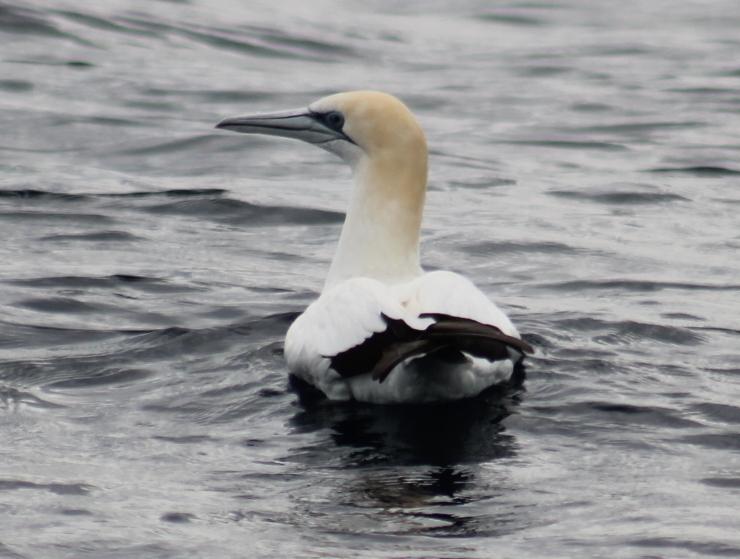
Their breeding habitat is on islands and the coast of New Zealand, Victoria and Tasmania, with 87% of the adult population in New Zealand. They normally nest in large colonies on coastal islands. In New Zealand there are colonies of over 10,000 breeding pairs each at Three Kings Islands, Whakaari / White Island and Gannet Island. There is a large protected colony on the mainland at Cape Kidnappers (6,500 pairs). There are also mainland colonies at Muriwai and Farewell Spit, as well as numerous other island colonies.
Gannet pairs may remain together over several seasons. They perform elaborate greeting rituals at the nest, stretching their bills and necks skywards and gently tapping bills together. The adults mainly stay close to colonies, whilst the younger birds disperse.
These birds are plunge divers and spectacular fishers, plunging into the ocean at high speed. They mainly eat squid and forage fish which school near the surface. It has the same colours and similar appearance to the northern gannet. Numbers of Australasian gannet have been increasing since 1950, although some colonies have disappeared and others have decreased in size.
Gannet pairs may remain together over several seasons. They perform elaborate greeting rituals at the nest, stretching their bills and necks skywards and gently tapping bills together. The adults mainly stay close to colonies, whilst the younger birds disperse.
These birds are plunge divers and spectacular fishers, plunging into the ocean at high speed. They mainly eat squid and forage fish which school near the surface. It has the same colours and similar appearance to the northern gannet. Numbers of Australasian gannet have been increasing since 1950, although some colonies have disappeared and others have decreased in size.
THE CHARM OF SYDNEY.
By M. Forrest.
In it because the sea is always near.
Whispering at windows, muttering round the piles,
Singing and chuckling underneath the wharf
Of strange, dark men and magic, haunted isles
Of tawny gold, and sparkling stones that lie,
Loot of the sea for many a moon gone by.
The factory wheels can never drown its voice.
Its fairy shallops brush against the walls
Of city yards, its spindrift rises high
By beetling rocks, mid everywhere there falls
The dancing rainbows of the summer sea.
Till Commerce marvels, seeing mystery.
Salt on the lip from high winds in the park,
Suck of strong currents underneath a ship,
Green weedy scents by ocean-crusted rails
Or spirit of the white-winged yachts that dip
Fleet as the gannets that for ever roam
To rise, to fall, along the racing foam!
We build our mighty buildings, stone and steel,
Shut out the fragile blue of summer skies,
We shape our huge machines of industry;
But. like a star, behind the black smoke lies
The charm of Sydney! In those walls of stone
A wave makes music, or a rose is blown.
We cannot press a finger on her pulse
And say, "Keep time to wisdom," for her eyes
Look far beyond us. From the East a sail
Has brought her tidings of enchanted skies.
Where argosies of some brave fancy ranged:
Sydney for ever changing, yet unchanged!
THE CHARM OF SYDNEY. (1932, March 26). The Australasian(Melbourne, Vic. : 1864 - 1946), p. 42. Retrieved from http://nla.gov.au/nla.news-article142423806
The wonderful Brown Skua, (Stercorarius antarcticus), also known as the Antarctic skua, subantarctic skua, southern great skua,southern skua, or hākoakoa (Māori), is a large seabird that breeds in the subantarctic and Antarctic zones and moves further north when not breeding. Its taxonomy is highly complex and a matter of dispute, with some splitting it into two or three species: Falkland skua (S. antarcticus), Tristan skua (S. hamiltoni), and subantarctic skua (S. lönnbergi). To further confuse, it hybridizes with both the south polar and Chilean skuas, and the entire group has been considered to be a subspecies of the great skua, a species otherwise restricted to the Northern Hemisphere.
It feeds on fish, other birds, small mammals, eggs and carrion. This is the heaviest species of skua and rivals the largest gulls, the great black-backed gull and glaucous gull, as the heaviest species in the shorebird order although not as large in length or wingspan. It is 52–64 cm (20–25 in) in length, 126–160 cm (50–63 in) in wingspan and has a body mass of 1.2–2.18 kg (2.6–4.8 lb). S. a. hamiltoni measured on Gough Island, weighed an average of 1.43 kg (3.2 lb) in 9 males and 1.65 kg (3.6 lb) in 9 females. S. a. lönnbergi measured in the Chatham Islands weighed an average of 1.73 kg (3.8 lb) in 30 males and an average of 1.93 kg (4.3 lb) in 32 females. The latter is the highest colony mean body mass for any living species of shorebird.
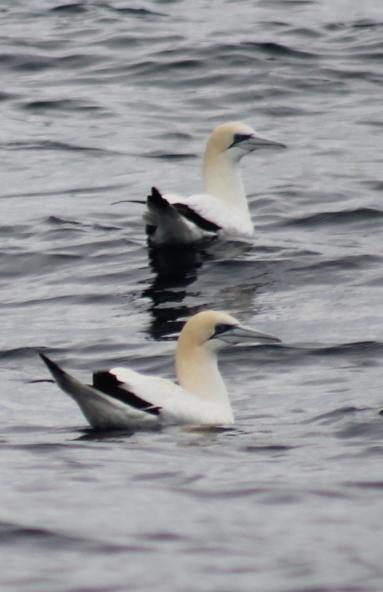 THE INLET.
THE INLET.At the curve of the shining reaches,
Where the seven black swans feed,
The waves have covered the beaches
With a carpet of coloured weed.
Of crimson and russet and sorrel,
Rose and purple and brown,
Where the ebb tides laugh and quarrel,
And the captured sunlights drown.
In the lee of the silver shallows,
In the lull of the freshening seas,
Gull after white gull follows,
In twenties and twos and threes.
Lonely the gannet paddles,
Proudly the dark swans ride,
Rocked in their cool green cradles,
Lapped in the lap of the tide.
Still in the thin sea-grasses,
Sings the old seawind keen;
Sunlight to sunlight passes,
And long cloud shadows between.
Still by the rocky ingle
And the clean shell-wrinklcd strand,
The waves fall light on the shingle,
The waves fall low on the sand.
Stars, and the swan's spread wings,
In the wake of the dying day.
And only the ageless sea wind sings
Alone in the lonely bay.
KATHLEEN DALZIEL.
THE INLET. (1930, April 12). The Sydney Morning Herald (NSW : 1842 - 1954), p. 11. Retrieved from http://nla.gov.au/nla.news-article16697443
THE ALBATROSS
Majestic bird! those wide-spread wings of white,
Perfect a type of some great, lonely soul,
Hovering over the dark Infinite
That hides from mortal ken the un-known goal,
Whither we urge while countless ages roll !
The broad sun glints - upon the lifting wave,
And thy clear eye doth meet his blinding beam ;
The day goes down in silence, sombre, grave,
And sad with mystery : Night reigns supreme,
But on unmoving' pinion poised you seem,
To pass and come again as in a dream.
What reek you of the calm-the storm-the cold ?
The changing challenge of the changeless Deep ?
Ton mete the marches of the liquid wold,
That rolls its undulations from the steep
Of the Antartic to the palm-fringed sweep,
Of Oceana's thousand isles that peep
Above the sapphire bosom of warm seas,
Where the black gale dies out in gentle breeze !
Life over Death; Hope amid blank Despair,
Thy flight doth symbolize eternally !
Moving, yet motionless, thou stemmest - Air,
And- seekest shelter with Air's stem ally,
Water-which Fire doth tinge supernally !
And there, strong child of Nature's wildest strength,
Graceful and noble, fearless, swift and free,
You dare the elements, and rove at length
Above the realms of the resounding sea;
Secure where safety is not; finding food
In the lost kingdoms of Earth's infant hood !
EDWARD NEWTON MCCULLOCH.
ORIGINAL POETRY. (1898, January 2). West Australian Sunday Times (Perth, WA : 1897 - 1902), p. 6. Retrieved fromhttp://nla.gov.au/nla.news-article32630766
References:
Black-browed albatross. (2015, June 15). In Wikipedia, The Free Encyclopedia. Retrieved from https://en.wikipedia.org/w/index.php?title=Black-browed_albatross&oldid=667031211
Australasian gannet. (2015, March 5). In Wikipedia, The Free Encyclopedia. Retrieved from https://en.wikipedia.org/w/index.php?title=Australasian_gannet&oldid=649967356
Brown skua. (2015, May 10). In Wikipedia, The Free Encyclopedia. Retrieved from https://en.wikipedia.org/w/index.php?title=Brown_skua&oldid=661644961
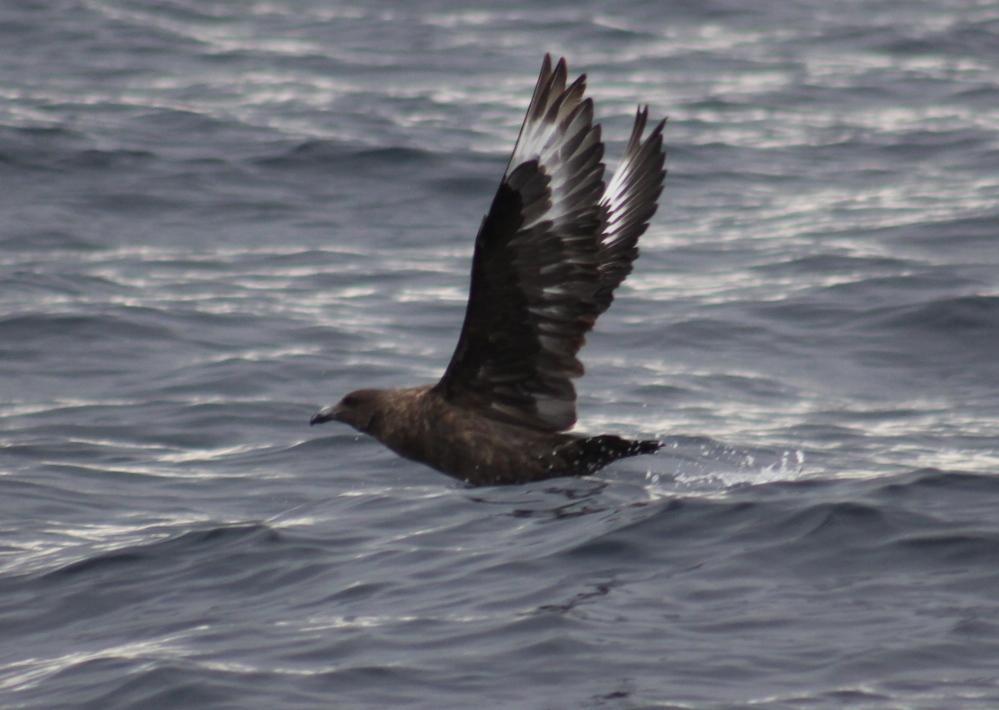
Brown Skua, (Stercorarius antarcticus) - A J Guesdon picture
